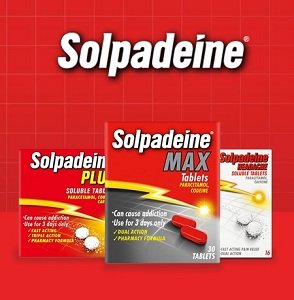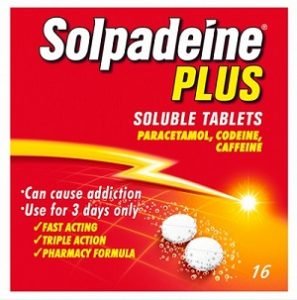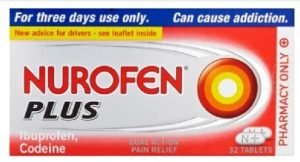Can you buy codeine over the counter? The short answer to the question is ‘yes’, however, codeine is only available in one form over the counter, and it is not in a tablet form. Without a doubt, over the counter codeine containing products are one of the most commonly sold medicines in the UK. Most codeine products are sold as a combination of medicines, codeine combined with another drug, for example, paracetamol.
Table of Contents
- What form of codeine can you buy over the counter in the UK?
- Over the counter codeine: where to buy?
- Is over the counter codeine the best pain killer?
- Differences in response to codeine treatment
- What is the highest amount of codeine available over the counter?
- Codeine over the counter: UK list of products.
- Prescription-only codeine
What form of codeine can you buy over the counter in the UK?
Over the counter (OTC) codeine is available in the following forms:
- Codeine linctus (syrup)
As I already mentioned in the introductory part, codeine can be purchased on its own only in one form. Codeine Linctus (syrup) can be bought from pharmacies. Each 5ml of codeine linctus contains 15mg of codeine phosphate.
- Co-codamol (paracetamol & codeine)
The most common form of codeine-containing medicine is co-codamol, which can be purchased over the counter from pharmacy counters. Co-codamol is a combination product containing 8mg of codeine and 500mg of paracetamol per tablet.
There are many other codeine containing-products which are available in pharmacies. Many branded products are sold, which are equivalent to co-codamol. Some branded products contain more than 8mg of codeine phosphate per tablet.
- Codeine and ibuprofen over the counter
It is possible to get codeine in combination with ibuprofen. Ibuprofen belongs to a different class of drugs than paracetamol, called nonsteroidal anti-inflammatory drugs (NSAIDs), which additionally to its pain-relieving properties, have anti-inflammatory action. Few products are currently available in the UK with both ingredients.
- Codeine and aspirin
Like ibuprofen, aspirin belongs to the NSAID group of drugs. At higher doses, aspirin can be taken to manage pain, fever and inflammation.
The above list is a general list of codeine and codeine-containing products. More specific products are reviewed in the latter part of this post.
Over the counter codeine: where to buy?
All over the counter codeine-containing products are pharmacy-only medicines (P). P medicines are sold in pharmacies only including online chemists, which operate under the supervision of a responsible pharmacist. Pharmacy-only medicines are not available for self-selection by customers.
Restrictions on the supply of over the counter codeine containing products
A few years back, the Government introduced ‘tighter controls’ for over the counter medicines containing codeine (and dihydrocodeine). The reason for restrictions was to minimise the risk of overuse and addiction, which is possible with codeine use. Since then, all restrictions have been in place. In particular:
- Codeine-containing products were only licensed for acute pain (for example to manage toothache), which is not relieved by paracetamol, ibuprofen or aspirin alone, except for codeine linctus, which can be used to manage non-productive coughs.
- Codeine products are pharmacy-only medicines with the sales restricted to pharmacies and online chemists only.
- Use of codeine-containing products is restricted to three days only products containing codeine over the counter are restricted to 32 tablets.
- Codeine-containing products should not be used by children under 12 years of age, except for a combination of aspirin and codeine, which can only be taken by adults and children over 16 years of age.
- Codeine linctus is licensed for adults 18 years of age and over.
Is over the counter codeine the best pain killer?
As per licensing restrictions, combination products with codeine are recommended if simple analgesics such as paracetamol or ibuprofen fail to control the pain. Combination of codeine and paracetamol may provide better pain relief than paracetamol alone. A systemic review (review of all existing evidence) which looked at 24 different clinical trials (single dose trials) concluded that ‘the analgesic effect between paracetamol-codeine combinations and paracetamol alone was small. This review included a range of codeine products, including higher doses of codeine combination drugs, which are not available over the counter (de Craen, et al., 1996).
In multi-dose studies (patient takes more than one dose of the drug), treatment with the paracetamol-codeine combination was associated with a significantly higher number of side effects as compared to paracetamol alone.
Differences in response to codeine treatment
A small proportion of codeine is changed in the body into morphine. It has to be noted that there is a significant variation in how people ‘process’ codeine. Some people (10% of white people, 2% of Asian people, and 1% of Arabic) are ‘poor metabolisers’ of codeine, which means that in this group of people, codeine will have little effect.
On the opposite, some people are ‘ultra‐metabolisers’, which means they convert codeine into more morphine in the body. This group of people is at risk of codeine toxicity, even at standard doses (Wiffen et al., 2016).
Some key reasons why people may respond differently to codeine:
Genetic Variations: Genetic differences can significantly impact how an individual’s body processes and responds to medications. Codeine is metabolized by an enzyme called CYP2D6, which converts codeine into its active form, morphine. However, some people have genetic variations that result in reduced or absent CYP2D6 activity, leading to reduced conversion of codeine to morphine. As a result, they may experience little or no pain relief from codeine.
Metabolism: Apart from genetic factors, an individual’s overall metabolism can affect codeine’s effectiveness. Metabolism refers to how quickly the body breaks down and eliminates a drug. Some people metabolize codeine rapidly, resulting in a quicker conversion to morphine and a stronger response to the medication. On the other hand, individuals with slower metabolism may experience a weaker response or potential side effects.
Tolerance: Over time, the body can develop a tolerance to codeine, meaning higher doses may be required to achieve the same level of pain relief. If someone has been taking codeine for an extended period, their response to the drug may be different compared to someone who is taking it for the first time.
Sensitivity and Individual Differences: People can have varying levels of sensitivity or reactions to medications, including codeine. Factors such as age, overall health, and the presence of other medical conditions can influence an individual’s response to codeine. Additionally, some people may be more prone to experiencing side effects, such as drowsiness, constipation, or nausea, while others may tolerate the medication well.
What is the highest amount of codeine available over the counter?
Codeine linctus contains the highest amount of codeine phosphate (15mg/5ml), although its licensed use is limited (see more in the next paragraph). The highest amount of codeine in codeine & paracetamol combination products is 12.8mg of codeine per tablet.
Codeine over the counter: UK list of products.
Over the counter codeine in cough medicines:
1. Codeine linctus
- Active ingredient: codeine phosphate
- Codeine content: 15mg of codeine per 5ml of linctus
- Age restrictions: codeine linctus is licensed in adults 18 years of age and over for symptomatic relief of non-productive (dry) coughs.
Other notes: Many pharmacies do not stock codeine linctus. Likewise, a pharmacist may not agree to sell codeine linctus over the counter, due to commonl misuse of this medication.
Codeine linctus is the only medication which contains codeine only with no other active ingredients.
2. Pulmo Bailly
Pulmo Bailly is an oral solution (syrup) containing two active ingredients:
- Codeine: 7mg per 5ml of syrup and
- Guaiacol (1949): 75mg per 5ml of syrup.
Pulmo Bailly is used to manage coughs caused by colds, including influenza (flu) and other respiratory tract infections. Pulmo Bailly is licensed for adults over 18 years of age.
Pulmo Bailly has been out of stock for a few years, however, no official information on the discontinuation of this product has been provided.
OTC codeine-containing painkillers
3. Co-codamol
Co-codamol is the most popular codeine-containing medication.
What are the active ingredients found in co-codamol?
- Active ingredients (per tablet): codeine phosphate (8mg) and paracetamol (500mg).
- Codeine content: 8mg per tablet.
Co-codamol is sold by most pharmacies and supermarket pharmacies as its own branded product, for example, Tesco Co-codamol,. Independent pharmacies may sell various of generic co-codamol tablets. A box of 32 co-codamol tablets costs around £3 (2023).
4. Veganin
- Active ingredients (per tablet): codeine phosphate (8mg), paracetamol (500mg) and caffeine (30mg).
- Codeine content: 8mg per tablet. The same amount of codeine content as co-codamol tablets.
Other notes: suitable for vegans and vegetarians.
5. Solpadeine Max tablets
Solpadeine is a popular brand of co-codamol.
What are the active ingredients found in Solpadeine Max?
- Codeine phosphate (12.8mg) and paracetamol (500mg).
- Codeine content: 12.8mg per tablet.
Solpadeine Max contains the highest amount of codeine phosphate which can be bought over the counter in combination with paracetamol.
Other notes:
Solpadeine Max tablets do not contain caffeine, but a soluble version of Solpadeine Max does contain caffeine.
Related post: Solpadeine alternative medicines.
6. Solpadeine Plus tablets/capsules
Solpadeine Plus is another medication in the range of Sopadeine. The active ingredients found in Solpadeine Plus:
- Codeine phosphate (8mg) paracetamol (500mg) and caffeine (30mg)
- Codeine content: 8mg per tablet.
Solpadeine Plus contains the same amount of codeine phosphate as standard -co-codamol.
7. Panadol Ultra tablets
- Active ingredients (per tablet): codeine phosphate (12.8mg), paracetamol (500mg).
- Codeine content: 12.8mg per tablet. The highest amount of codeine phosphate available over the counter in the form of codeine & paracetamol combination.
8. Migraleve tablets
Migraleve range of tablets is mostly known for their use in the symptomatic management of migraines. Migraleve, like other codeine products, can be used to treat moderate pain, which is not relieved by paracetamol, ibuprofen, or aspirin alone. Migraleve range is sold in the form of three different products. All Migraleve products are pharmacy-only medicines, which can be used by adults and children over 12 years of age. Migraleve was out of stock for most of 2019 due to licensing issues, which are now resolved, and there is no stock issue with Migraleve products. At that time, I wrote a post about Migraleve alternative products, which may interest you.
Migraleve contains two different tablets inside one pack: pink and yellow tablets.
Active ingredients in PINK Migraleve tablets:
- Active ingredients (per tablet): codeine phosphate (8mg), paracetamol (500mg) and buclizine hydrochloride (6.25mg)
- Codeine content: 8mg per tablet.
Other notes: Buclizine hydrochloride is an antihistamine, which is included in the formulation to relieve symptoms of nausea associated with migraines.
Active ingredients in YELLOW Migraleve tablets:
- Active ingredients (per tablet): codeine phosphate (8mg) and paracetamol (500mg).
- Codeine content: 8mg per tablet. An equal amount of codeine to ‘standard’ co-codamol tablets.
Which Migraleve tablet should you take first: Pink or Yellow?
Pink Migraleve tablet(s) should be taken on the onset of a migraine; if more tablets are needed t control the symptoms, one should take yellow Migraleve tablet(s), every four hours.
For more detail, please refer to the product information leaflet.
Migraleve pink and yellow tablets can be purchased as individual (separate) products.
As you can tell from the above, there is no difference between Miraleve Yellow tablets and Co-codamol in terms of their active ingredients.
9. Syndol tablets
- Active ingredients (per tablet): codeine phosphate (10mg), doxylamine succinate (5mg), paracetamol (450mg) and caffeine (30mg).
- Codeine content: 10mg per tablet. A higher concentration of codeine than in ‘standard’ co-codamol.
Other notes: Syndol tablets contain additional doxylamine succinate when compared to Syndol Headache Relief Tablets. Doxylamine is an antihistamine, which acts as an antiemetic agent (stops nausea), which can be associated with migraines.
10. Syndol Headache Relief tablets
- Active ingredients (per tablet): codeine phosphate (10mg) paracetamol (500mg) and caffeine (30mg).
- Codeine content: 8mg per tablet. The same amount of codeine phosphate as in ‘standard’ co-codamol.
Soluble (effervescent) codeine over the counter
Soluble (effervescent) tablets dissolve in the water giving a solution (water + drug). Generally, it can be said that soluble tablets absorb and get to work faster than standard tablets.
11. Solpadeine Max soluble
Solpadeine Max soluble tablets have similar composition of active ingredients to Solpadine Max tablets. However, Solpadine Max soluble contains caffeine.
Active ingredients (per tablet):
- Codeine phosphate (12.8mg), paracetamol (500mg) and caffeine (30mg).
- Codeine content: 12.8mg per tablet.
The highest amount of codeine phosphate available over the counter in the form of codeine & paracetamol combination.
12. Solpadeine Plus soluble
Solpadeine Plus soluble tablets have the same composition of active ingredients as Solpadine Plus tablets (non-effervescent):
Active ingredients (per tablet):
- Codeine phosphate (8mg), paracetamol (500mg) and caffeine (30mg)
- Codeine content: 8mg per tablet.
The same amount of codeine phosphate as in standard -co-codamol or generic co-codamol effervescent (next paragraph).
13. Co-codamol effervescent (‘generic’)
Generic, including, cheap(er) supermarket and pharmacy versions of co-codamol are usually sold as effervescent co-codamol, which contains 8mg of codeine and 500mg of paracetamol per tablet.
There are many generic and branded versions of co-codamol effervescent (with or without caffeine), for example, Ultramol soluble tablets, Paracodol tablets. Their availability varies between pharmacies.
Combination of codeine and ibuprofen
In the last part of this post, I will list the most common combination medicines which contain ibuprofen and codeine as active ingredients. Ibuprofen belongs to a group of drugs called nonsteroidal anti-inflammatory drugs (NSAIDs) and unlike paracetamol, can be taken to help with inflammation in addition to its properties as a painkiller.
14. Nurofen Plus
Nurofen Plus is probably the best-known brand of codeine and ibuprofen combination medicine.
- Active ingredients (per tablet): codeine phosphate (12.8mg) and ibuprofen (200mg).
- Codeine content: 12.8mg per tablet.
The highest amount of codeine phosphate available over the counter.
Similarly to paracetamol-codeine medicines, Nurofen Plus can be taken by adults and children over 12 years of age.
15. Ibuprofen & codeine (Almus)
Ibuprofen and codeine by Almus is a ‘cheaper’ alternative to Nurofen Plus. Almus Ibuprofen & Codeine contains the same amount of codeine per tablet as Nurofen Plus.
16. Boots ibuprofen and codeine tablets
Boots ibuprofen and codeine tablets represent the same combination of active ingredients as Nurofen Plus tablets, namely ibuprofen 200mg per tablet and codeine phosphate 12.8mg per tablet.
Combination of codeine and aspirin
Aspirin belongs to the same class of drugs as ibuprofen – NSAIDs. At higher doses (more than 300mg daily), aspirin is usually taken to help with pain (headache, toothache etc.), to reduce temperature (antipyretic effect) and to reduce inflammation. A lower dose aspirin, baby aspirin (75mg) may be recommended by a GP as secondary prevention of cardiovascular disease, for example, in patients who had a heart attack or stroke.
17. Codis 500
Codis 500 contains two active ingredients:
- Aspirin: 500mg per tablet
- Codeine: 8mg per tablet
As with other codeine products, Codis 500 is recommended for short-term management of pain, which is not relieved by other analgesics such as paracetamol alone. Codis 500, aspirin, and other aspirin-containing products should not be used in children under the age of 16.
Codis 500 are soluble tablets and need to be dissolved in the water before administration.
18. Boots aspirin & codeine tablets
Boots aspirin and codeine tablets are licensed for adults and children over 16 years of age. Two main active ingredients found in Boots Aspirin & codeine tablets:
- Codeine phosphate: 8mg per tablet
- Aspirin: 400mg per tablet
The licensed use for Boots and aspirin and codeine tablets is the same as previously discussed codeine products.
Prescription-only codeine
Codeine phosphate tablets on its own are prescription-only medicines (POM). Codeine available on prescription can be prescribed on its own or in combination with paracetamol. When prescribed, there are no restrictions in terms of quantity that can be prescribed by a GP.
Codeine is usually available in a pack of 28 tablets. Prescription-only co-codamol exists in pack sizes of up to 100 tablets or capsules. POM versions of codeine & co-codamol medicines include:
- Codeine 15mg tablets
- Codeine 30mg tablets
- Codeine & paracetamol (co-codamol) is available in the form of tablets and capsules with 500mg of paracetamol per tablet/capsule, and either 8mg, 15mg, or 30mg of codeine.
References
de Craen AJ, Di Giulio G, Lampe-Schoenmaeckers JE, Kessels AG, Kleijnen J. Analgesic efficacy and safety of paracetamol-codeine combinations versus paracetamol alone: a systematic review. BMJ. 1996 Aug 10;313(7053):321-5. doi: 10.1136/BMJ.313.7053.321. PMID: 8760737; PMCID: PMC2351742. Available at: https://doi.org/10.1136/bmj.313.7053.321 Accessed on 17/07/2023
P, Phillips T, Moore RA. Paracetamol (acetaminophen) with or without codeine or dihydrocodeine for neuropathic pain in adults. Cochrane Database of Systematic Reviews 2016, Issue 12. Art. No.: CD012227. DOI: 10.1002/14651858.CD012227.pub2. Accessed 17 December 2020. Available at: https://doi.org/10.1002/14651858.CD012227.pub2 Accessed on 17/07/2023














